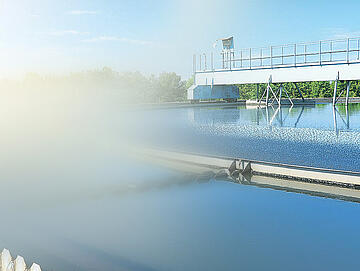
The Analysis of Biological Parameters in Wastewater
- A universal workflow for the detection of organisms
- Indirect mass tests as a monitoring system – (well) beyond the pandemic
- Putting wastewater to use as a data source as part of critical infrastructure
Genetic information, including virus particles and other germs are detectable in wastewater above a certain level of concentration. In cooperation with Endress+Hauser, Analytik Jena is the only European company to provide the full process chain – from sampling in the treatment plant to detection in the lab.
An investment in life
Data collection for water quality and health
Complementary approach to epidemiology
For all types of pathogens: from influenza viruses to cholera, multi-resistant germs to legionella
One workflow for all types of genetic material
Well designed and proven for reliable routine measurements
Expanding on data collection for the critical infrastructure
Well designed and proven process
The Endress+Hauser CSF 48 sampler collects and generates samples at treatment plants in full automation.
From the concentration of target organisms to the final PCR result: lab work in around three hours.
Up to 16 or 96 samples at a time: The InnuPure C16 touch pipetting platform and (at a higher throughput) the CyBio FeliX purify samples and isolate nucleic acids.
The real-time thermocyclers of the qTOWER3 product family amplify and detect genetic material using a PCR test.
Anonymized mass tests for use in epidemiology
As seen during the corona pandemic at the latest, data collection from wastewater is no longer a far-off dream. As an early warning and monitoring system, it is expected to become part of the critical infrastructure meant to protect the population and avoid dangers to the natural environment – in connection with safe reuse of the water as well. Likely areas of application include:
- Antibiotic-resistant germs
- Gastrointestinal viruses (e.g. Noro, Cholera)
- Influenza viruses (SARS-CoV-2)
- Salmonella, Legionella, Clostridium, E. coli
- Hepatitis
- Polio
The cellular rudiments of disease-causing organisms and viruses are excreted from the body. Traces of them in wastewater provides a type of anonymized mass test, allowing for data collection on the health of the population, while not interfering with personal rights and not requiring people to volunteer information.
The potential of wastewater-based epidemiology (WBE) is only beginning to be fully recognized. In some countries such as the Netherlands and Australia, this principle is being used all throughout the country with regard to COVID-19. An EU recommendation from March 17, 2021 provided that the wastewater treatment plants of cities with a population of at least 150,000 should be regularly monitored for its SARS-Cov-2 viral load at the very least. The EU also recommends that critical infrastructure such as hospitals, senior citizen homes, and airports should be regularly tested. It is important, in any case, that the selected measuring method is maintained over time to provide comparable results and reliable information on trends.
The Process Chain
Analytik Jena makes it all possible – with a workflow that can be used universally for all biological parameters and is capable of 16 or 96 samples per run.
Step 1: Sampling in the treatment plant
The fully automatic Endress+Hauser Liquistation CSF48 sampler begins by taking samples, with the mobile CSP44 variant in use upstream.
Step 2: Concentration of target organisms
The sample is concentrated in order to detect the target organisms. Subsequent to electronegative filtration, the virus fragments and particles are removed from the filter membrane using the SpeedMill PLUS. The process is several times faster than the time-consuming ultrafiltration that can only process a handful of samples at a time.
Step 3: Sample isolation in the lab
Analytik Jena pipetting robots are at work here – either
- the InnuPure C16 touch, which processes up to 16 samples
- or the CyBio FeliX for 96 samples.
Both offer ready-to-use protocols which – in combination with the relevant extraction kits – automatically purify DNA or RNA from the samples.
Step 4: Detection
The qTOWER³ system takes on detection using fluorescence measurement. Within the polymerase chain reaction (PCR), the targeted DNA or cDNA segment is copied and marked with fluorescence. The more often the series of letters in question appears, the stronger the signal becomes in the real-time PCR process and the clearer it can be determined how high the viral load actually is.
Our Equipment in Operation
Insights into analyzing biological parameters, especially for samples as difficult as wastewater from which genetic information is extracted, were unthinkable just a few years ago. Analytik Jena is involved in the development of the standards - with its own know-how and in partnership with the relevant institutes.
SARS-CoV-2 detection in Japan
Analytik Jena's PCR devices have been in use in Japan for SARS-CoV-2 detection in wastewater since 2020.
"Regardless of the sample matrix, low concentrations of genes could be detected."
Dr. Akihiko Hata, Toyama Prefectural University, Japan
Tested by the largest water management association in Germany
The Emschergenossenschaft/Lippeverband (EGLV), Germany's largest water management association, has tested the overall process at one wastewater treatment plant and is transferring it to nine others.
Cooperation with the Bauhaus University Weimar
A project with the Bauhaus University Weimar is in preparation, which aims to establish a holistic wastewater monitoring approach.
Exclusive e-book: Water and wastewater analysis
Our exclusive e-book offers a comprehensive overview of methods and solutions for water and wasterwater monitoring - from UV/Vis spectroscopy, sum parameter analysis to elemental analysis and microbiological testing.
Tracking SARS-CoV-2 in wastewater
Monitoring wastewater for biological parameters such as pathogens like SARS-CoV-2 – or Coronavirus as it is more commonly known – can be a valuable data resource for an effective COVID-19 management. However, there are several challenges involved in detecting biological parameters in wastewater. Fortunately, there are also several solutions available to overcome them.
Downloads AppNotes, Publications and further material for detection of biological parameter in wastewater
Contact
The newsletter of Analytik Jena frequently keeps you posted about:
- News
- Trends and developments
- Events
